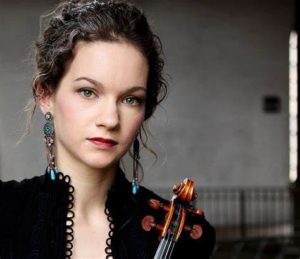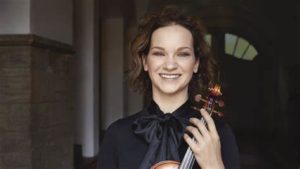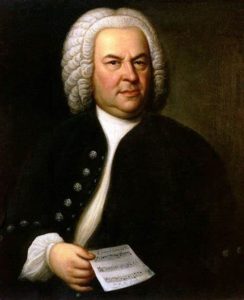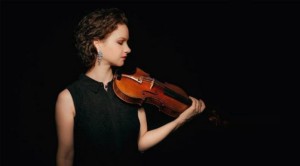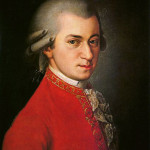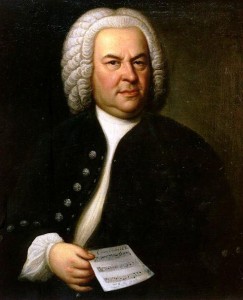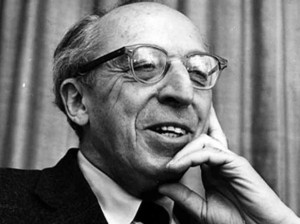Hilary Hahn’s solo recital on March 12 was truly great. The word astonishing fits except that it is not a surprise when Ms Hahn performs in a way that combines flawless technique with emotion, color, and devotion to the music. While hearing her play three of Johann Sebastian Bach’s works for solo violin, I knew that this was pure Bach. There is no ego or personal style filtering the music. The music did not need such additions; it was exciting, an on-the-edge-of- the-seat experience. It was pure music.
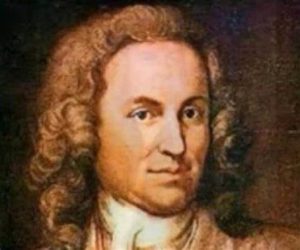 Johann Sebastian Bach (1685-1750)
Johann Sebastian Bach (1685-1750)
The program offered Sonata No. 1 in G minor, BWV 1001; Partita No. 1 in B minor, BWV, 1002; and, after intermission, Partita No. 2 in D minor, BWV 1004.
Purity does not mean that it was simple. Every note, every multiple note created a world of sound. Sound is a real, physical thing. It can change the world around it. Sound can move mountains; consider an avalanche.
The Sonata No. 1 in G minor is listed first of Bach’s six works for solo violin. Its parts are Adagio, Fuga: Allegro, Siciliano, Presto. The order of Slow, Fast, Slow, Fast is intentional. It balances classical order with the interweaving of free imagination and openmindedness. There is a mathematical intelligence at play. My college roommate, Leah Johnson Wilcox, was a math major. I knew she knew games of balance and dimensions and that I would never be able to play on that field. Ms Hahn’s superb intelligence is a wonderful match with Bach’s. Together, they explore balance, space, rhythms; they play with time and space. The listener is joyfully immersed in the mathematics of music without really knowing it is happening.
The Partitas have movements named for dances. The Siciliano in Sonata No. 1 is the only dance character in the Sonatas. Baroque dances were crazy complicated in their patterning of order. Partita No. 1 in B minor opens with an Allemande, and then its Double; next comes a Courante and its Double: Presto; Sarabande, and its Double; Tempo di Borea (Bourree) – and its Double. The Double is an ancestor of a jazz variation; it spins out something new from a standard. Here, the music takes off from the musical idea of the dance movement first presented. The rhythms and characters of the dances go beyond a restatement of a physical, 18thc. dance. The music tells us the DNA of a Courante’s running motion or the Sarabande’s dignity and sadness. It is not only the heart of the music in motion; it exposes Bach’s understanding of the electrical pulses and chemical interactions that keep it alive.
Restraint can be beautiful. Order can breathe. These violin solo works are not embroidered or showing off innovation. They combine profound creativity with their classic forms.
There were moments in the recital when I am certain I heard Bach speak. Did Bach invent music? I know that is not true, not entirely true. It only seems that way sometimes. There are not adequate ways to describe Ms Hahn’s greatness. Standing alone on an empty stage, she filled the stage and Davies Hall with her presence and her powerful connection to the music she made.
The Partita No. 2 in G minor shares its format with Partita No. 1 but its Fate led it somewhere else. This one has no Doubles, but it does have five movements: Allemande, Courante, Sarabande, Gigue, and Chaconne. The mood of the first four movements is tinged with reflection, controlled order; if we were to use Romantic thoughts we might find regret. The Gigue (Jig) takes rhythm over the mountain, dancing with wild energy which takes the rhythmic demands farther than one could expect, and even farther than that. And then, there is the Chaconne. It is very long, so long as the all the first four movements together. It gives us a theme and then sixty-four variations. I do not remember breathing as I heard this majestic music. It gathers the knowledge of music’s world and, in the last two strokes of the bow, made my heart stop in awe.
For more about Ms Hahn, please see the article at http://www.livelyfoundation.org/wordpress/?p=1359 about her Davies Hall recital on April 26, 2016, with Cory Smythe, pianist. The program included work by Mozart, Bach, Aaron Copland, and Tina Davidson’s Blue Curve of the Earth, the winner of a competition for new encore pieces sponsored by Ms Hahn.
